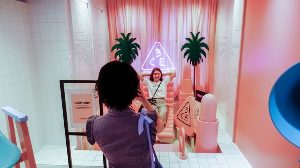Retailers opening stores that don’t sell anything
Visitors passed through mirrored rooms with umbrellas suspended from the ceiling and took photos of the pop-up space that opened for a short time at the end of last year but had nothing for sale.
Tuesday, April 26th 2022, 9:57AM
by Sally Lindsay

These are known as Instagram pop-up stores that send a message to customers about the brand and create “dream like landscapes” to encourage online shopping.
Such spectacles are becoming commonplace for shoppers, says Taylor Coyne JLL retail research manager.
Retail brands across the world are creating Instagram-ready rooms that focus on wowing the customer and encouraging social media posts.
The trend is a boon for commercial real estate landlords renting these spaces to pop-ups and longer-term installations, says Coyne.
“It’s a phenomenon. These spaces are not really designed for sales. They are much more about sending a message to customers. And they are a way to bring people into physical spaces when so much shopping is happening online.”
In Downtown Los Angeles, beauty retail behemoth Sephora took over an old theatre and sold tickets to a “personal immersion” event, where guests could frolic in tubs of gold confetti, sit on gigantic faux watermelon wedges and pose on a flower-bedecked pink convertible. In New York City, beauty brand Winky Lux launched a Winky Lux Experience, replete with life-sized lemon juicers and tiny tea rooms.
Brands are investing in these spaces with little expectation of a return in the form of sales, but Coyne says the press mileage and social media buzz generated by these showcases is invaluable.
“People come in, take photos and tag the brands — it’s a great exercise in visibility,” she says. “In terms of exposure, it pays for itself. That is especially important given that many of the brands doing these events are new and emerging, and have to find a way to stand out.”
These pop-ups can run for a few days up, a few months, or longer. The Museum of Ice Cream, which has had pop-ups in Los Angeles and New York, has a permanent home in San Francisco, where visitors can gaze at cookie carousels and loll about in tubs of sprinkles. Visitors pay $38 to get in; ice cream included.
La La Land
While the trend in Instagram-able stores in the US it is starting to extend globally. It is not only about the experience but designed to move product as well. Individual rooms in pop-ups are designed in accordance with the products showcased within them.
In Singapore late last year, Giorgio Armani took over a large glass box, installed a red gorilla at the front, and allowed shoppers to take photos in the “Lip Maestro” room, where an entire wall was studded with shiny red balloon lips.
“This trend particularly suits beauty and fashion brands because of the ability to weave whimsical visual stories out of product selections,” Coyne says.
What’s next?
After several instances of flower-bedecked entrances and ball pits stuffed with anything but balls, Coyne says retailers need to continue thinking “outside the box” in order to differentiate themselves.
“The more retailers can align their Instagram rooms and spaces with their brand, the more room for innovation they have,” she says. “With this influx of new brands selling similar goods, creating a clear and defined brand for customers to relate to should naturally help create unique spaces.”
Especially given that, despite the plethora of these pop-ups, shoppers don’t seem to have grown tired of them yet.
“I’m not sure when we’ll reach the tipping point,” Coyne says. “I think there’s more room for growth before we see the trend tapering off.”
| « Records to topple for commercial and industrial sales | CBD retail and recovery chances » |
Special Offers
Comments from our readers
No comments yet
Sign In to add your comment
| Printable version | Email to a friend |


